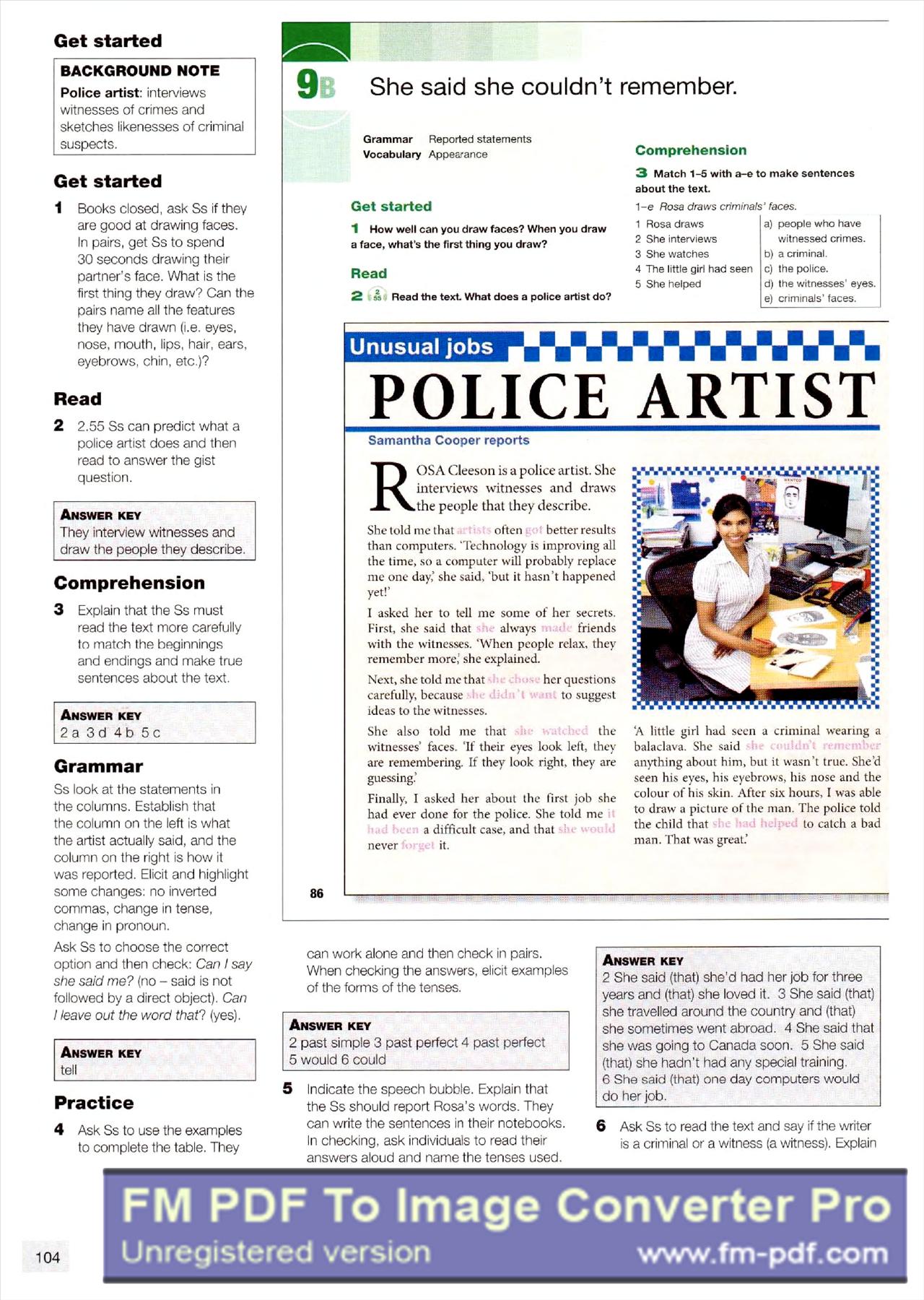UpŠat 3 Teacher's Book podrecznik nauczyciela plus odpowiedzi ,testy,klucz answer key Page 103

Get started
BACKGROUND NOT─ś
Police artist: interviews witnesses of crimes and sketches likenesses of criminal suspects.

Grammar Reported statements Yocabulary Appea'ance
Get started
1 Books closed, ask Ss if they are good at drawing faces.
In pairs, get Ss to spend
30 seconds drawing their partner sface. What isthe first thing they draw? Can the pairs name all the features they have drawn (i.e. eyes, nose, mouth, lips, hair, ears, eyebrows. chin, etc.)?
Read
2 2.55 Ss can predict what a police artist does and then read to answer the gist guestion.
Comprehension
3 Explain that the Ss must read the text mor─Ö carefully to match the beginnings and endings and make true sentences about the text.
Grammar
Ss look at the statements in the columns. Establish that the column on the left is what the artist actually said, and the column on the right is how it was reported. Elicit and highlight some changes: no inverted commas, change in tense. change in pronoun.
Answer key
They inten/iew witnesses and draw the people they describe.
Answer key
2a 3d 4b 5c
86
1 How well can you draw faces? When you draw a face, whatŌĆÖs the first thing you draw?
2 Ł Read the text. What does a police artist do?
[
3 Match 1-5 with a-e to make sentences about the text.
1-e Rosa draws criminalsŌĆÖ faces.
1 Rosa draws
2 She interviews
3 She watches
4 The little girl had seen
5 She helped
a) people who have witnessed crimes.
b) a criminal.
c) the police.
d) the witnesses eyes.
e) criminalsŌĆÖ faces.
ROSA Cleeson i$ a police artist. She interviews witnesses and draws the people that they describe.
She told me that often better results
than computers. Technology is improving all the time, so a Computer will probably replace me one day,ŌĆÖ she said, 'but it hasn t happened yetiŌĆÖ
I asked ber to tell me some of her secrets. First, she said that always friends
with the witnesses. ŌĆśWhen people rclax, they remember mor─Ö,ŌĆÖ she explained.
Next, she told mc that hcr ─ģuestions
carefully, because to suggest
ideas to the witnesses.
She also told me that the
witnesses* faces. If their eyes look left, they are remembering. If they look right, they are guessing.ŌĆÖ
Finally, I asked her about the first job she had ever done for the police. She told me a difficult case, and that never it.

V\ little girl had scen a criminal wearing a balaclava. She said
anything about him, but it wasnT true. She <3 seen his eyes, his eyebrows, his nose and the colour of his skin. Aftcr six hours, I was able to draw a picture of the man. The police told the child that to cateh a bad
man. That was great.ŌĆÖ
Ask Ss to choose the correct option and then check: Can I say she said me? (no - said is not followed by a direct object). Can I ieave out the word that? (yes).
can work alone and then check in pairs. When checking the answers. elicit examples of the forms of the tenses.
Answer key
tell
Practice
4 Ask Ss to use the examples to complete the table. They
Answer key
2 past simple 3 past perfect 4 past perfect 5 would 6 could
5 Indicate the speech bubble. Explain that the Ss should report RosaŌĆÖs words. They can write the sentences in their notebooks. In checking. ask individuals to read their answers aloud and name the tenses used.
Answer key
2 She said (that) she'd had her job for three years and (that) she loved it. 3 She said (that) she travelled around the country and (that) she sometimes went abroad. 4 She said that she was going to Canada soon. 5 She said (that) she hadnŌĆÖt had any special training.
6 She said (that) one day computers would do her job._
6 Ask Ss to read the text and say if the writer is a criminal or a witness (a witness). Explain
FM PDF To Image Corwerter Pro
Unregistered version www.fm-pdf.com
104
Wyszukiwarka
Podobne podstrony:
Up?at 3 Teacher s Book podrecznik nauczyciela plus odpowiedzi ,testy,klucz answer key Page 051 Get s
Up?at 3 Teacher s Book podrecznik nauczyciela plus odpowiedzi ,testy,klucz answer key Page 069 Get s
Up?at 3 Teacher s Book podrecznik nauczyciela plus odpowiedzi ,testy,klucz answer key Page 027 Get s
Up?at 3 Teacher s Book podrecznik nauczyciela plus odpowiedzi ,testy,klucz answer key Page 067 e Cor
Up?at 3 Teacher s Book podrecznik nauczyciela plus odpowiedzi ,testy,klucz answer key Page 001 FM PD
Up?at 3 Teacher s Book podrecznik nauczyciela plus odpowiedzi ,testy,klucz answer key Page 005 Conte
Up?at 3 Teacher s Book podrecznik nauczyciela plus odpowiedzi ,testy,klucz answer key Page 006 Conte
Up?at 3 Teacher s Book podrecznik nauczyciela plus odpowiedzi ,testy,klucz answer key Page 009 FM PD
Up?at 3 Teacher s Book podrecznik nauczyciela plus odpowiedzi ,testy,klucz answer key Page 010 : Rea
Up?at 3 Teacher s Book podrecznik nauczyciela plus odpowiedzi ,testy,klucz answer key Page 012 Large
Up?at 3 Teacher s Book podrecznik nauczyciela plus odpowiedzi ,testy,klucz answer key Page 013 u mfo
wi─Öcej podobnych podstron